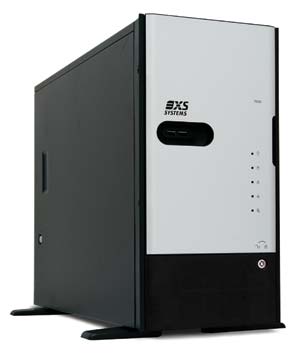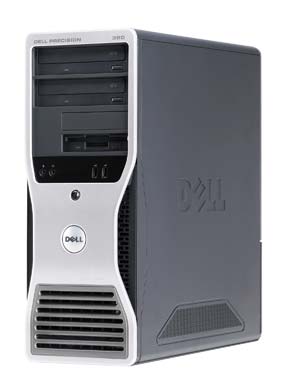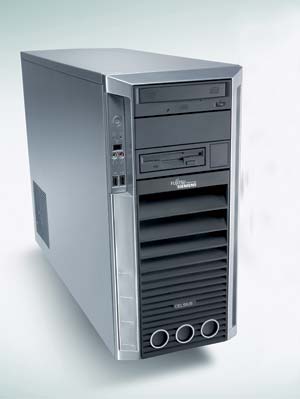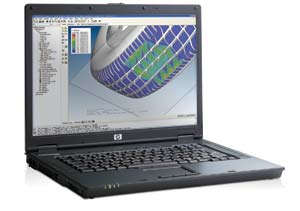Despite the introduction of dual core processors from AMD and Intel, there is still a huge demand in the CAD sector for single processor machines, which offer plenty of power without breaking the bank.
 |
 |
 |
 |
| Workstation | CAD2 Imagine FX3800-64 | Scan 3XS | FJ Celsius V830 | Dell Precision 380 | HP nw8240 mobile workstation |
|---|---|---|---|---|---|
| Processor type and clock speed | 3.80GHz Intel Pentium 4 670 | 2.2GHz AMD Opteron 148 | 2.6 GHz AMD Opteron 252 | 3.0GHz Intel Pentium 4 630 | 2.13GHz Intel Pentium M 770 |
| Memory | 3GB PC2-4200 533MHz Dual-Channel DDR-2 | 2GB DDR PC3200 | 2GB DDR400 ECC | 1GB 533MHz DDR2 SDRAM | 1GB |
| Graphics card | Nvidia Quadro FX 1400 | Nvidia Quadro FX1400 | Nvidia Quadro FX 540 | ATI FireGL V3100 | ATI FireGL V5000 Mobility |
| Hard driver | 2x Seagate Barracuda 7200.9 160GB S-ATA 300 (Raid 0) | 2 x 250GB Samsung SpinPoint SATA300 (Raid 0) | 2 x 160Gb SATA II 7,200RPM | 80GB SATA | 80GB 5,400 RPM |
| Price | ú1,595 | ú1,225 | ú1,599 | ú599 | ú1,589 |
Scan 3XS

Scan 3XS
- 2.2GHz AMD Opteron 148 (Socket 939)
- 2GB DDR PC3200 memory
- Nvidia Quadro FX1400 128MB graphics card
- 2 x 250GB Samsung SpinPoint SATA300 Hard drives (Raid 0)
- Asus A8N-SLI Premium Edition Mainboard
- NEC 4550 x16 Dual Layer DVD-Writer
- Windows XP Professional (SP2)
- ú1,225
Virtually all AMD Opteron-based workstations on the market at the moment can carry two physical processors. And if you’re talking about two dual core CPUs this gives you a quad processor machine on your desktop, with serious power for multithreaded applications.
While a machine with this level of multi-processor power will get visualisation and analysis specialists more than a little excited, the average CAD user, whose application is likely to be single threaded, isn’t really going to know what to do with the additional processors. Yes, the ability to multitask, or run two applications concurrently, without a significant drop in performance is a major benefit, but if you’re predominantly focussed on running a single CAD application, it’s also a bit of a luxury.
With this in mind there continues be a huge demand for single processor workstations, but despite AMD treading on Intel’s toes at the top end of the market, we’ve yet to see any Opteron workstations to rival the Pentium 4 in terms of price/performance – until now, that is.
Scan’s latest 3XS workstation is that machine, a single processor Opteron workstation built around a single processor motherboard, but most importantly with a price tag of ú1,225.
For this price, the Scan 3XS doesn’t include the highest specification Opteron CPU there is, but the Opteron 148, which runs at 2.2GHz. Despite its mid-range positioning in AMD’s Opteron family (AMD’s top-end Opteron 154 runs at 2.8GHz), the processor is still able to deliver excellent performance under a cross section of CAD applications.
CPU and graphics aside, Scan has implemented 2GB DDR PC3200 memory, two striped (Raid 0) 250GB Samsung SpinPoint SATA300 hard drives, and an ASUS A8N-SLI motherboard. While this motherboard is primarily designed for AMD Athlon processors, it is able to accommodate the new socket 939 Opterons. In addition, the suffix denotes that it is SLI capable, so you can add another Quadro FX 1400 graphics card in the future should you want to, which will very much depend on whether Nvidia solves the problems it’s been having with SLI on Windowed OpenGL applications (see The Truth about SLI on www.aecmag.com for more on this).
Finally, it’s also worth a mention that unlike a lot of Opteron machines we’ve seen, the 3XS was remarkably quiet throughout all of our testing, which is down to the highly capable cooling system that Scan has employed. This consists of three large parallel fans – one of which is an integral part of the CPU’s heatsink and is perpendicular to the motherboard – which route air efficiently from the front to the rear of the machine.
In conclusion, the CAD sector has been crying out for a machine like this. The Opteron has finally been delivered in a single processor system giving CAD users access to all the power of AMD’s CPU without having to pay a premium for a dual processor platform. This, coupled with Scan’s excellent build quality, makes the 3XS workstation an extremely exciting proposition for the workstation market in 2006.
Dell Precision 380

Dell Precision 380
- 3.0GHz Intel Pentium 4 630
- 1GB 533MHz DDR2 SDRAM
- ATI FireGL V3100 128MB graphics card
- 80GB SATA hard drive
- 48x CD-RW/DVD combo drive
- Multimedia card reader
- Windows XP Professional (SP2)
- ú599
A recent survey in our sister publication, MCAD, showed that 40% of CAD users are still using a desktop PC, rather than a dedicated workstation. In the survey we didn’t ask the reasons behind this choice, but we guess that, on the whole, it all boils down to price. You can easily pick up a PC for under ú600, but most workstations cost two, three, even four times this amount. So why is this? Obviously a lot of it comes down to specification, with top end processors, buckets of memory and high speed 3D graphics, but this ‘additional’ cost is also due to certification – an assurance that you will be fully supported on your chosen hardware and, in practical terms, the knowledge that your graphics card will display an exact representation of your design, or at least if any problems do occur that they will be looked into and rectified with new driver releases.
So what if you could buy a certified workstation for virtually the same price as a PC? Well, thanks to a new promotion between Dell and ATI, you can. Dell is currently offering one of its entry level Precision 380 workstations for a mere ú599. For this you get a 3.0GHz Pentium 4 630, 1GB 533MHz DDR2 SDRAM, an entry-level ATI FireGL V3100 graphics card, an 80GB (7,200RPM) SATA drive, 48x CD-RW/DVD combo, media card reader and Gigabit Ethernet. Windows XP Professional (SP2) comes as standard and you also get a three year next day on site service.
So what’s the catch? Well, as far as we can see there doesn’t seem to be one. Yes, the specification is ‘entry-level’, and you’re not going to get cutting edge performance, but this ‘special’ configuration of the Precision 380 still offers mid range CAD users a more than capable certified platform for CAD work, at prices never previously seen between the pages of AEC magazine.
Upgrades are also available and ú60 will buy you an additional 1GB of memory, which we think is money well spent. There’s also an upgrade path to an ATI FireGL V7100 graphics card for ú400, but marrying this high-end card with a 3.0GHz Pentium 4 processor will probably mean the performance is mismatched for most users.
Fujitsu Siemens Celsius V830

Fujitsu Siemens Celsius V830
- 2.6 GHz AMD Opteron 252
- 2GB DDR400 ECC memory
- Nvidia Quadro FX 540 128MB graphics card
- 2 x 160Gb SATA II 7,200RPM hard drives
- DVD/R/W Double Layer drive
- Integral WLAN 802.11g 54Mbps
- Windows XP Professional (SP2)
- ú1,599
If we handed out prizes for size and sheer bulk, Fujitsu Siemens’ Celsius V830 would win hands down. Its huge chassis is extremely solid in construction, and you get the feeling you could drop one of these industrial units onto concrete and it wouldn’t complain too much (not that we’re endorsing you do this, of course).
While there isn’t always a direct correlation between size and computational performance, the V830 has all the trademark specifications of a serious high-end workstation. Typically, this is one that is built around two AMD Opteron processors, but to fit in with our requirement for single processor workstations this month the review machine only featured a single Opteron 252, which runs at 2.6GHz – but more on this later on.
If the Celsius doesn’t get the attention of the whole office simply by getting it out of its box, it certainly will when you start it up. Like many Opteron machines, the V830 makes a substantial amount of noise at first, with all three fans running full whack, but things calm down once Windows has booted up. More importantly, the machine remained relatively quiet even when running our compute intensive CAD applications, which is great news for densely populated offices.
In terms of CPU performance the Celsius came out top in virtually all of our tests. However, despite sporting one of the fastest single core processors on offer, the Celsius is kitted out more conservatively in the graphics department, with a Quadro FX 540. While this card will be more than adequate for all 2D and most 3D CAD applications, some may find its performance lacking a little under more graphics intensive applications such as 3ds Max.
Out of all the workstations on test this month, the Celsius V830 is by far the most flexible in terms of future upgrades. With only 2GB PC3200 DDR memory, the Gigabyte GA-2CEWH motherboard still has six spare DIMM slots which should provide more than enough headroom for those wishing to work with large models on 64-bit Operating Systems such as Windows XP, or the forthcoming Windows Vista. The Gigabyte GA-2CEWH motherboard is also SLI capable, although the dual graphics card technology is not supported in the entry level Quadro FX 540, so you’d need to buy two brand new cards for this. You could however, buy another Quadro FX 540 to drive another monitor. There’s also the option of adding a second processor, and this could become even more important as more and more CAD vendors tune their applications for multithreaded operations.
As it stands, the Celsius V830 still offers excellent performance in its single processor configuration. For some it will fall a little short in the graphics department, but this can be remedied by upgrading to one of the many Quadro FX alternatives on offer, such as the FX 1400, FX 3400 or FX 4500.
Combining this single processor performance with the flexibility of a workstation that could last you well into the future does come at a cost, but Opteron workstations are coming down in price across the board and the Celsius V830 still offers excellent value for money.
CAD2 IMAGINE FX3800-64 Workstation

CAD2 IMAGINE FX3800-64 Workstation
- 3.80GHz Intel Pentium 4 670
- 3GB PC2-4200 533MHz Dual-Channel DDR-2
- Nvidia Quadro FX 1400 128MB graphics card
- 2x Seagate Barracuda 7200.9 160GB S-ATA 300 hard drives (Raid 0)
- Intel D955XBK Advanced Workstation Motherboard
- Pioneer 110D 16x Dual Layer +/- Multi-Format DVD ReWriter Drive
- Windows XP Professional (SP2)
- ú1,595
Over the past few years CAD 2 has made a name for itself in the workstation sector by consistently providing extremely well constructed machines packed with quality components. The Imagine FX3800-64 is no exception and the first indication of this is the new CoolerMaster WaveMaster case, whose aluminium alloy construction gives the machine a solid reliable look and feel. Inside you’ll find CAD 2’s trademark Intel workstation motherboard (in this case the D955XBK), custom cabling, cable clips and sound and vibration insulation lining the inside of the case.
The Intel D9555XBK features all the standard workstation technologies including four Serial ATA interfaces with RAID support, a single PCI Express x16 slot, four DDR2 SDRAM DIMM sockets (with support up to 8GB) and room for a single Pentium 4, Pentium D or Pentium 4 Extreme Edition processor.
With single threaded applications still the mainstay of the CAD market, CAD 2 has chosen Intel’s Pentium 4 670 3.80GHz, which is currently the fastest single core processor that Intel offers. This is likely to be the case for some time as Intel, like AMD, is putting its money into dual core (two chips on a single piece of silicon) for its future generation CPUs.
In terms of memory the Imagine FX3800-64 features 3GB DDR2 memory in 2 x 1GB DIMMs and 2 x 512MB. This might sounds like an odd configuration, but tallies with the physical limit imposed by 32-bit Windows XP Professional when the /3GB switch is invoked. The downside is that should you wish to move to Windows XP x64 Edition in the future and upgrade your memory, you’ll have to strip out and replace the 512MB DIMMs.
CAD 2 has also configured its two Seagate Barracuda 7200.9 160GB S-ATA 300 hard drives in a novel way. One partition on its Raid 0 array has been formatted with the standard 4k cluster size (for standard data usage) while the other has been given 8k clusters (which is designed to accelerate the loading of large models). In practice we found a slight performance advantage when loading a large assembly in Autodesk’s Inventor CAD product on the 8k cluster partition, but the assembly in question also referenced a number of small parts. It would be interesting to see the effect of loading a large single file on this partition, such as a single DWG in AutoCAD.
On test, the Imagine FX3800-64 gave a good account of itself across the board, particularly impressing under all of our 3D intensive application benchmarks.
In summary, with impressive build quality and good all round performance the CAD 2 Imagine FX3800-64 Workstation provides an excellent platform on which to run your CAD application. With all four memory DIMMs full and what looks like being the top end single core processor from Intel for some time, your hands are tied when it comes to upgrading. But with the Intel D9555XBK motherboard also able to run dual core processors and 2GB DIMMS, there’s still flexibility for the future if you don’t mind swapping out your components.
HP nw8240 mobile workstation

HP nw8240 mobile workstation
- 2.13GHz Intel Pentium M 770
- ATI Mobility FireGL V5000
- 1GB DDR2 memory (max 2GB)
- 80GB 5,400 RPM hard drive
- Mobile Intel 915PM Express Chipset
- Microsoft Windows XP Professional
- ú1,589
HP’s previous generation mobile workstation, the nw8000, was a quality piece of kit, but lacked the finesse of some of its peers; its box-like form also made it difficult to type comfortably for extended periods. HP looks to have learnt some lessons from the nw8000, and its replacement, the nw8240 is a much more refined machine. Its chassis is more slender, the full size keyboard is a pleasure to use, and following the lead of manufacturers like Dell, the nw8240 sports an impressive 15.4 widescreen 1,920 x 1,200 resolution display.
In order to facilitate this high resolution screen the unit is noticeably larger than its predecessor with a width and depth comparable to the Dell Precision M70. However, unlike Dell’s flagship mobile workstation, HP’s nw8240 is extremely slender, measuring only 28mm at the front and as a result weighing in at a very respectable 2.77kg.
As is still standard in virtually all mobile workstations Intel’s Pentium M takes centre stage in the nw8240. The processor, which features 2MB L2 cache, offers a serious amount of performance for CAD, which becomes even more remarkable considering how little power it draws from the battery. Our review machine featured the Pentium M 770 (2.13GHz), although HP also offers the new Pentium M 780 (2.26GHz) for those looking to maximize their processing power. Still, the Pentium M 770 is no slouch, and has enough processing power to keep up with the desktop machines on test this month.
Rather than kit out the machine with its maximum 2GB of DDR2 memory, our review machine featured a total of 1GB. Depending on your requirements for CAD on the go, this is a decent amount, but if you commonly work with large models, run a number of applications concurrently, or carry out complex analysis or rendering calculations, adding the additional 1GB will be money well spent.
Graphics-wise the machine features ATI’s 128MB Mobility FireGL V5000, which provides a solid foundation for the majority of 3D CAD applications. While the 5,400RPM 80GB Serial ATA hard drive gives users ample storage space, some might find it a little slow loading up large models. Of course, HP also offers 7,200RPM drives in 60GB, 80GB, or 100GB sizes.
Elsewhere, the nw8240 features all the typical components you’d expect to find in a workstation class laptop –DVD+/-RW, Type I/II PCMCIA PC card slot, Intel Wireless LAN 802.11b/g Mini PCI card, integrated Bluetooth, NetXtreme Gigabit (10/100/1000 NIC) PCI Express Ethernet Controller, integrated Smart Card Reader, secure digital slot, three USB 2.0 and one Firewire port. There’s also an impressive 16-bit sound system which has speakers nestled either side of the keyboard.
In the nw8240 HP has developed a highly impressive successor to the nw8000, not only totally reworking it in terms of form, but refining its screen to accommodate the increasingly popular widescreen format. N.B. for those that don’t get on with such high resolution displays, HP also offers the option of a 15.4″ WSXGA screen at 1,680 x 1,050.
Performance wise, while the nw8240 holds its own under CPU intensive operations, it is not the fastest mobile workstation out there when it comes to 3D graphics, playing second fiddle to Dell’s Precision M70 and its Nvidia Quadro FX Go1400 graphics card. However, the HP does win hands down when it comes to portability and styling, and for this it demands close attention. But at the same time it’s also worth keeping a watchful eye on the next generation of mobile workstations, which are likely to be out in the next few months, and based on Intel’s new Core Duo processor.






